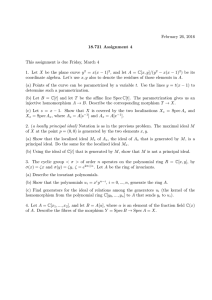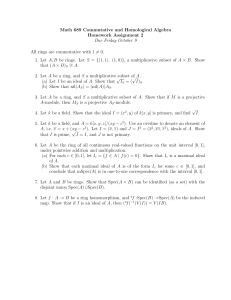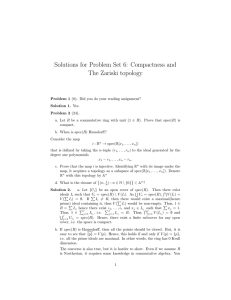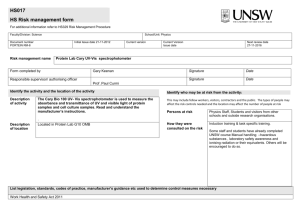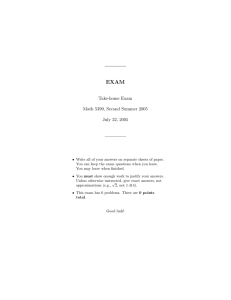Higher real K-theories 1 Real K-theory Arnav Tripathy
advertisement
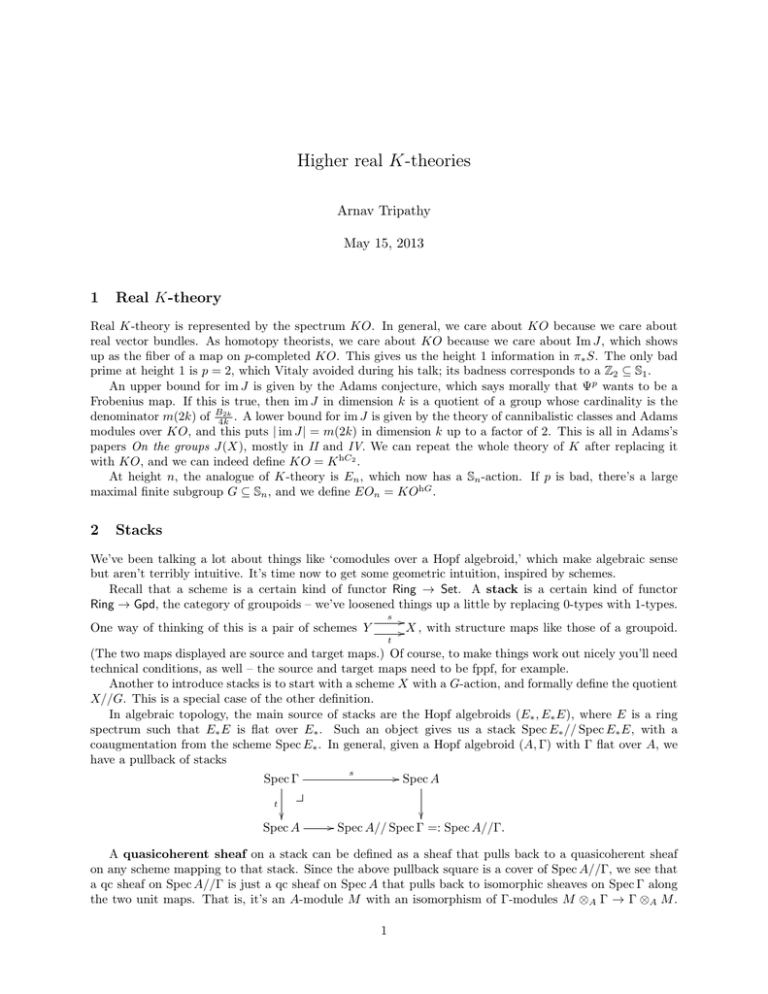
Higher real K-theories Arnav Tripathy May 15, 2013 1 Real K-theory Real K-theory is represented by the spectrum KO. In general, we care about KO because we care about real vector bundles. As homotopy theorists, we care about KO because we care about Im J, which shows up as the fiber of a map on p-completed KO. This gives us the height 1 information in π∗ S. The only bad prime at height 1 is p = 2, which Vitaly avoided during his talk; its badness corresponds to a Z2 ⊆ S1 . An upper bound for im J is given by the Adams conjecture, which says morally that Ψp wants to be a Frobenius map. If this is true, then im J in dimension k is a quotient of a group whose cardinality is the denominator m(2k) of B4k2k . A lower bound for im J is given by the theory of cannibalistic classes and Adams modules over KO, and this puts | im J| = m(2k) in dimension k up to a factor of 2. This is all in Adams’s papers On the groups J(X), mostly in II and IV. We can repeat the whole theory of K after replacing it with KO, and we can indeed define KO = K hC2 . At height n, the analogue of K-theory is En , which now has a Sn -action. If p is bad, there’s a large maximal finite subgroup G ⊆ Sn , and we define EOn = KOhG . 2 Stacks We’ve been talking a lot about things like ‘comodules over a Hopf algebroid,’ which make algebraic sense but aren’t terribly intuitive. It’s time now to get some geometric intuition, inspired by schemes. Recall that a scheme is a certain kind of functor Ring → Set. A stack is a certain kind of functor Ring → Gpd, the category of groupoids – we’ve loosened things up a little by replacing 0-types with 1-types. s / One way of thinking of this is a pair of schemes Y / X , with structure maps like those of a groupoid. t (The two maps displayed are source and target maps.) Of course, to make things work out nicely you’ll need technical conditions, as well – the source and target maps need to be fppf, for example. Another to introduce stacks is to start with a scheme X with a G-action, and formally define the quotient X//G. This is a special case of the other definition. In algebraic topology, the main source of stacks are the Hopf algebroids (E∗ , E∗ E), where E is a ring spectrum such that E∗ E is flat over E∗ . Such an object gives us a stack Spec E∗ // Spec E∗ E, with a coaugmentation from the scheme Spec E∗ . In general, given a Hopf algebroid (A, Γ) with Γ flat over A, we have a pullback of stacks s / Spec A Spec Γ t Spec A / Spec A// Spec Γ =: Spec A//Γ. A quasicoherent sheaf on a stack can be defined as a sheaf that pulls back to a quasicoherent sheaf on any scheme mapping to that stack. Since the above pullback square is a cover of Spec A//Γ, we see that a qc sheaf on Spec A//Γ is just a qc sheaf on Spec A that pulls back to isomorphic sheaves on Spec Γ along the two unit maps. That is, it’s an A-module M with an isomorphism of Γ-modules M ⊗A Γ → Γ ⊗A M . 1 2 Of course we can peel off one of these Γs, thus defining a qc sheaf on Spec A//Γ as an A-module M with a map of A-modules M → Γ ⊗A M satisfying some axioms. If you look at this, you’ll realize it’s exactly the definition of a Γ-comodule. (You may be concerned since we haven’t distinguished between left and right comodules, but in fact we shouldn’t! The conjugation/inverse structure map gives us a canonical equivalence of the two categories.) Given a qc sheaf (comodule) F, we can take the cohomology RHom∗ (OSpec A//Γ , F). In degree zero, this should just be the global sections of F. What are the global sections of F if it corresponds to the comodule M ? Well, they’re just maps A → M that agree whichever way you go around the pullback square – that is, they’re eq(M ⇒ M ⊗A Γ). This is the box or cotensor product AΓ M , also known as HomΓ (A, M ). Letting Sect be the global sections functor, we have Sect(Spec A//Γ, −) = Sect(Spec A, −) ◦ (AΓ −). Since Spec A is affine, it has no higher cohomology, so the Grothendieck spectral sequence for the right derived functors of this composition collapses, giving RSect∗ (Spec A//Γ, F) = Cotor∗Γ (A, M ). That is, the mysterious Cotor functor is just sheaf cohomology! Example 1. Let E = M U . By the results of Quillen, the stack Spec M U∗ //M U∗ M U is equivalent to the stack (now viewed as a functor from rings to groupoids) FGLs // strict isomorphisms. In fact, we can also write this as Spec L//G, where L is the Lazard ring and G is a group acting on it. The ANSS starts from ∼ ∗ ∼ ∗ ∼ ∗ M U∗ R M U∗ M U M U∗ X = H (Spec L//G, F) = H (G, F(Spec L)) = H (G, M U∗ X). When X = S, this is just H ∗ (G, L). Example 2. The classical ASS comes from Spec Fp //A∗ . But Spec Fp is a point, so this is a global group quotient. If we replace A∗ with A(1)∗ or something else of finite rank, we get honest-to-god group cohomology. 3 Computing EnhG Consider the ANSS for BP converging to π∗ EnhG . We have a commutative square Spec En∗ / Spec En∗ //G Spec BP∗ f / MpF Gc . The lower right hand corner is the moduli stack of p-typical formal groups with coordinates. We don’t actually get a map to Spec BP∗ since taking orbits gives us a formal group, not a formal group law. Proposition 3. K(n)-locally, BP∗ EnhG ∼ = f∗ OSpec En∗ //G as a sheaf on MpF Gc . ‘The Morava change-of-rings theorem should now be obvious.’ =1 As an aside, MpF Gc has a stratification M=0 pF Gc ∪ MpF Gc ∪ · · · by the height of the formal groups it’s parametrizing. A sheaf being K(n)-local means that it’s supported on the nth stratum. If ι : M=n → M is the inclusion, we have RΓ(ι∗ F) = RΓ(Rι∗ F) (since ι is affine), which is RΓ(F) (by the Lurie spectral sequence). Also, M=n is the stack Spec K(n)∗ //Σ(n)∗ , where Σ(n)∗ = K(n)∗ ⊗BP∗ BP∗ BP ⊗BP∗ K(n)∗ . There’s also an En -local version of this, where we look at sheaves supported on M≤n . The MCOR theorem appears as changing stacks to Spec En∗ //En∗ En . Now, Spec En∗ //G → M is (probably) affine, so the above argument gives us RΓ(Rf∗ OSpec En∗ //G ) ∼ = H ∗ (G, En∗ ), = RΓ(Spec En∗ //G, OSpec En∗ //G ) ∼ and G is finite, so we can (probably) replace the ANSS with a homotopy fixed point spectral sequence. HG 3. COMPUTING EN 3 Example 4. Let n = 2 and p = 2. We can show that G ∼ = GL2 (F3 ), and Spec E2∗ //G corresponds to the moduli stack of supersingular height 2 elliptic curves over F4 , of which there’s only one. En∗ is complete, so Spec E2∗ //G = Spf E2∗ //G. Serre-Tate deformation theory over a perfect field k of positive characteristic p tells us that a deformation of an abelian variety is the same as a deformation of its p-divisible group (the pro-abelian formal group of all its p-power torsion). Thus ∼ ∧ Spf(E2∗ //G) ∼ = Mss 1,1 = M1,1,ss , the ss denoting ‘supersingular,’ and this is a sixfold quotient of MWeierstrass .


